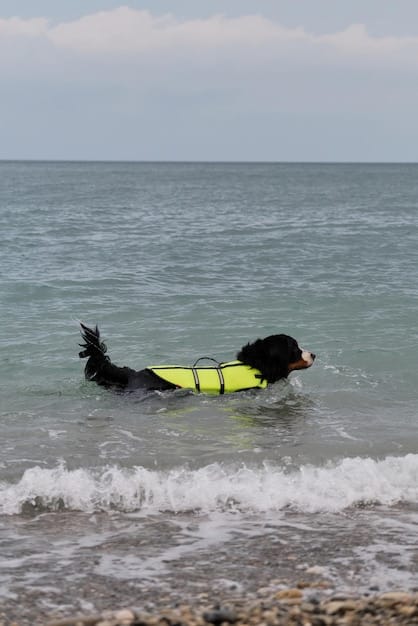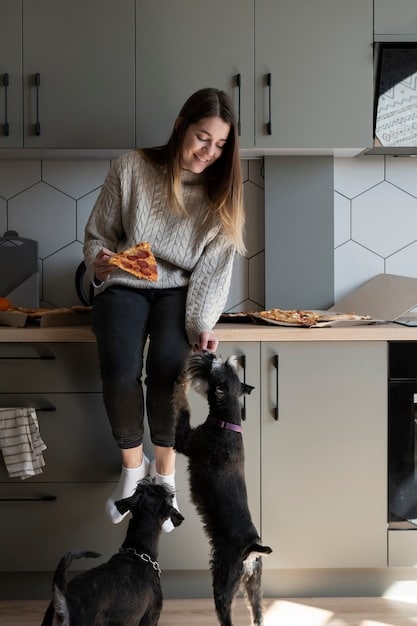Stop Counter Surfing: Training Your Dog to Stay Away

Counter surfing can be a frustrating and potentially dangerous behavior in dogs, but with consistent training techniques focusing on positive reinforcement and clear boundaries, you can successfully teach your dog to stay away from the kitchen counter.
Is your furry friend constantly snatching food off the kitchen counter? Counter surfing is a common and often frustrating behavior that many dog owners face. But don’t worry, with the right training techniques, you can teach your dog to keep all four paws on the floor and away from tempting treats.
Understanding Why Dogs Counter Surf
Before you can effectively tackle the issue of counter surfing, it’s essential to understand why dogs engage in this behavior in the first place. It’s not simply about being “naughty”; there are several underlying reasons.
The Thrill of the Hunt
For many dogs, counter surfing is driven by instinct. Dogs are natural scavengers, and the kitchen counter presents a treasure trove of interesting smells and potential rewards. The act of searching for and finding food can be incredibly stimulating.
Positive Reinforcement (Even Unintentional)
Even if your dog only occasionally finds something delicious on the counter, this intermittent reward can be enough to reinforce the behavior. The occasional success keeps them coming back for more. Your dog thinks “I only found something great once in a while, but I’m going to keep checking!”.
- Scavenging Instinct: Dogs are natural scavengers driven by their sense of smell and desire for food.
- Attention-Seeking: Sometimes, dogs counter surf to get attention from their owners, even if it’s negative attention.
- Boredom: A bored dog might turn to counter surfing as a way to entertain themselves, especially if they’re left alone for long periods.
Understanding these motivating factors will allow you to tailor your training approach more effectively, addressing the root cause of the counter surfing behavior.
Setting Up a Counter-Surfing Free Zone
The first step in tackling counter surfing is to make the kitchen counter as unappealing as possible. This involves managing the environment to reduce temptation and opportunities for your dog to practice the unwanted behavior.
Keep Counters Clear
This might seem obvious, but it’s the most crucial step. Don’t leave food or anything else your dog might find interesting on the counter. Even a seemingly harmless item, like a wrapper or a used plate, can be enough to entice them.
Use Deterrents
Consider using deterrents that make the counter less appealing. These could include things like double-sided sticky tape (which dogs dislike) or motion-activated noisemakers. Make sure anything you use is safe for your pet.

Block Access When Possible
If you can’t supervise your dog, consider blocking access to the kitchen altogether. This could involve using a baby gate or keeping the kitchen door closed. This is especially helpful during times when you know you’ll be busy and unable to monitor them closely
- Clear Temptations: Remove all food and appealing items from countertops.
- Physical Barriers: Use baby gates or close doors to restrict access to the kitchen when unsupervised.
- Scent Deterrents: Apply unpleasant (but safe) scents to the edges of counters to discourage exploration.
By making the counter less accessible and less appealing, you’re setting your dog up for success and preventing them from reinforcing the counter surfing behavior.
Essential Training Techniques
While environmental management is important, training is crucial for permanently addressing counter surfing. These techniques should be consistent, patient, and always rely on positive reinforcement.
The “Leave It” Command
This is a foundational command that teaches your dog to ignore tempting objects. Start by placing a treat on the floor and covering it with your hand. When your dog tries to get to the treat, say “Leave it!” As soon as they back away, even for a split second, praise them and give them a different, equally rewarding treat from your other hand.
The “Off” Command
If your dog is already on the counter, the “Off” command is essential. Lure your dog off the counter with a treat. When they have all four paws on the floor, give them the treat and praise them enthusiastically. Never yell at or physically punish your dog for being on the counter, as this can create fear and anxiety.

Rewarding Alternative Behaviors
Instead of just focusing on what you *don’t* want your dog to do, teach them what you *do* want them to do. Reward them for exhibiting calm, appropriate behaviors in the kitchen, such as lying on their bed or sitting quietly on the floor.
- “Leave It” Practice: Regularly practice the “leave it” command with various items around the house.
- Consistent “Off” Command: Use a firm but gentle tone when giving the “off” command.
- Positive Reinforcement: Always reward desired behaviors with treats, praise, or toys.
By consistently using these training techniques and focusing on positive reinforcement, you can teach your dog to make better choices and stay away from the kitchen counter.
The Power of Positive Reinforcement
Positive reinforcement is the key to effective dog training, including addressing counter surfing. It involves rewarding desired behaviors to make them more likely to occur in the future. This approach is much more effective than punishment, which can create fear and anxiety and damage your relationship with your dog.
Treats and Praise
Use high-value treats that your dog finds irresistible. Combine treats with enthusiastic praise to create a positive association with the desired behavior. The more enthusiastic you are, the more effective the training will be.
Timing is Everything
Reward your dog immediately after they exhibit the desired behavior. This helps them understand the connection between their actions and the reward. Even a few seconds delay can confuse your dog.
Consistency is Key
Everyone in the household needs to be on board with the training plan and use the same commands and rewards. Inconsistency can confuse your dog and make training more difficult.
- High-Value Rewards: Use treats that your dog loves and reserves specifically for training.
- Immediate Gratification: Reward desired behaviors within seconds of them occurring.
- Unified Approach: Ensure that all family members consistently enforce the same rules and commands.
By focusing on positive reinforcement and being consistent in your approach, you’ll create a rewarding and enjoyable training experience for both you and your dog.
Addressing Common Challenges
Even with consistent training, you may encounter some challenges along the way. It’s important to be patient and persistent, and to adjust your approach as needed.
Consistency Breeds Success
One of the biggest challenges is maintaining consistency, especially when you’re busy or tired. Remember that every time your dog successfully counter surfs, it reinforces the behavior, setting you back.
Don’t Give Up
Some dogs are more persistent than others. Don’t get discouraged if you don’t see results immediately. Keep practicing and adjust your training as needed. It’s important to celebrate small victories along the way.
Seek Professional Guidance
If you’re struggling to address counter surfing on your own, consider seeking guidance from a certified professional dog trainer. They can help you identify underlying issues and develop a customized training plan.
- Stay Consistent: Enforce the rules even when you’re tired or distracted.
- Be Patient: Training takes time, so don’t get discouraged by setbacks.
- Consult a Professional: Seek guidance from a qualified trainer if you’re facing significant challenges.
By acknowledging inevitable hurdles and tackling them head-on, you’ll boost your chances of effectively curbing counter surfing and nurturing a well-behaved dog.
Long-Term Management and Prevention
Once you’ve successfully addressed counter surfing, it’s important to maintain good habits to prevent the behavior from returning. This involves continued environmental management and reinforcement of training.
Regular Reinforcement
Continue to reinforce the “leave it” and “off” commands on a regular basis, even after your dog has stopped counter surfing. This will help them maintain good habits and prevent relapse.
Keeping Temptations Out of Reach
Continue to keep counters clear and avoid leaving food within your dog’s reach. Even if they’ve been well-trained, temptation can still be a strong motivator.
Providing Alternative Outlets
Make sure your dog has plenty of opportunities for exercise and mental stimulation. A bored dog is more likely to engage in unwanted behaviors, including counter surfing.
- Consistent Training: Dedicate time regularly to refresh obedience skills and commands.
- Ongoing Prevention: Maintain a clean countertop environment to minimize potential enticements.
- Enrichment Activities: Ensure your dog receives sufficient physical and mental engagement to deter boredom-driven actions.
By making a conscious effort to maintain good habits, you can ensure that your dog remains a well-behaved and happy member of the household for years to come.
| Key Point | Brief Description |
|---|---|
| 🍎 Clear Counters | Keep food off counters to remove temptation. |
| 🚫 “Leave It” Command | Train your dog to ignore tempting objects. |
| 🐾 Reward Good Behavior | Praise and treat when your dog stays away. |
| 🚪 Block Access | Use gates to prevent unsupervised access. |
Frequently Asked Questions
▼
Dogs counter surf due to their scavenging instincts, seeking rewarding smells and tastes. Even an occasional find reinforces the behaviour, making them check the counters again. Boredom and seeking attention also play a role.
▼
Begin by clearing the counters to remove the temptation. Teach commands like “Leave it” and “Off,” positively reinforcing good behaviour with treats and praise. Consistency and patience are key to success.
▼
Positive reinforcement entails rewarding desired behaviours to encourage recurrence. Rather than using punishments, it builds a positive relationship with your dog while they learn, promoting trust and obedience.
▼
Training duration varies based on your dog’s persistence and consistency in training. Some dogs may learn quickly in a few weeks, while tenacious dogs may need a few months. Persistence and steady reinforcement are essential.
▼
If you are still struggling, seek advice from a certified professional dog trainer or behaviourist. They can assess the problem and offer personalized strategies tailored to your dog’s specific needs and behaviour.
Conclusion
Effectively addressing counter surfing requires a combination of environmental management, consistent training, and positive reinforcement. By understanding why dogs engage in this behavior and implementing the techniques outlined above, you can successfully teach your dog to keep their paws on the floor and enjoy a safer, more harmonious relationship.





